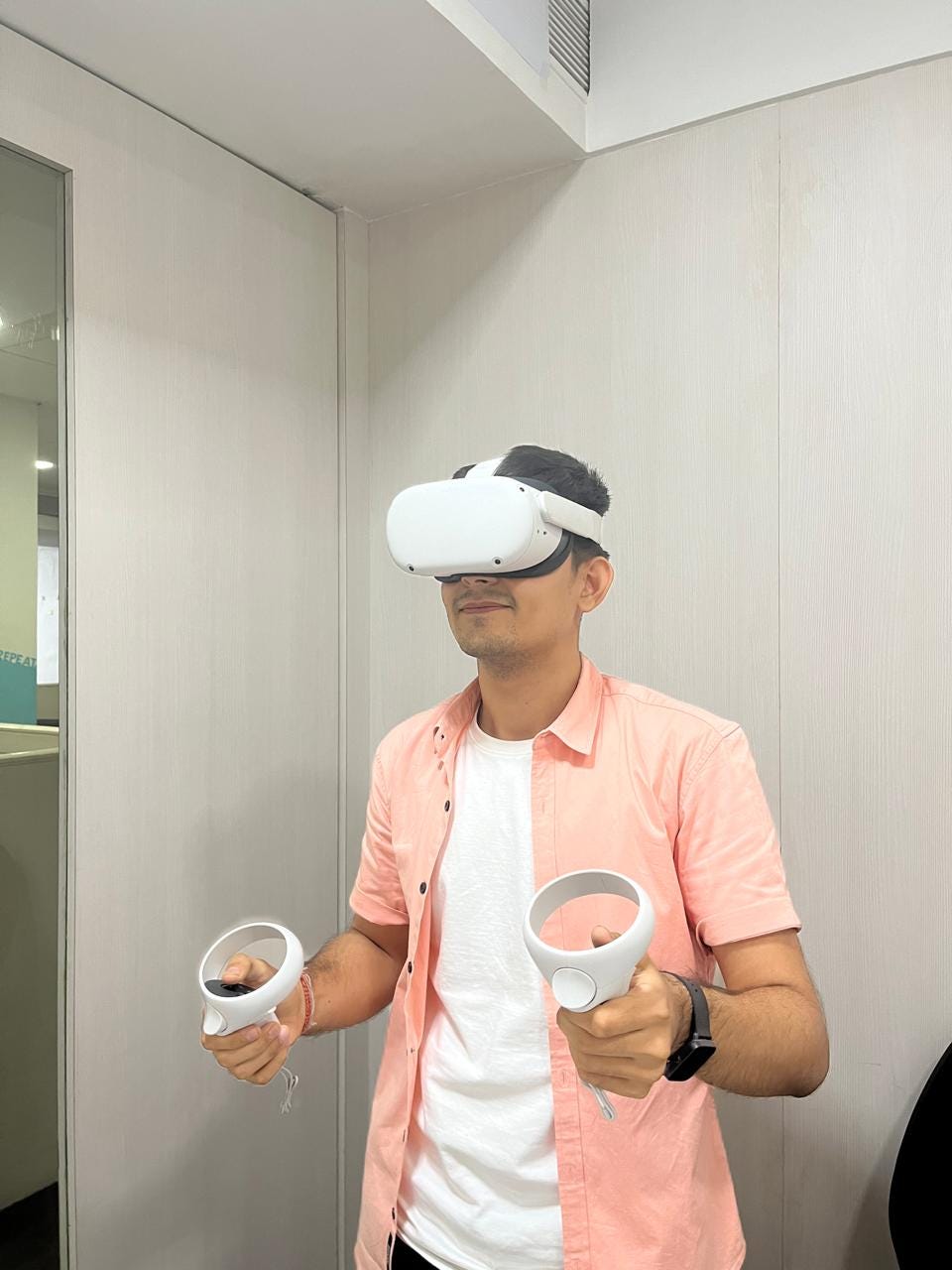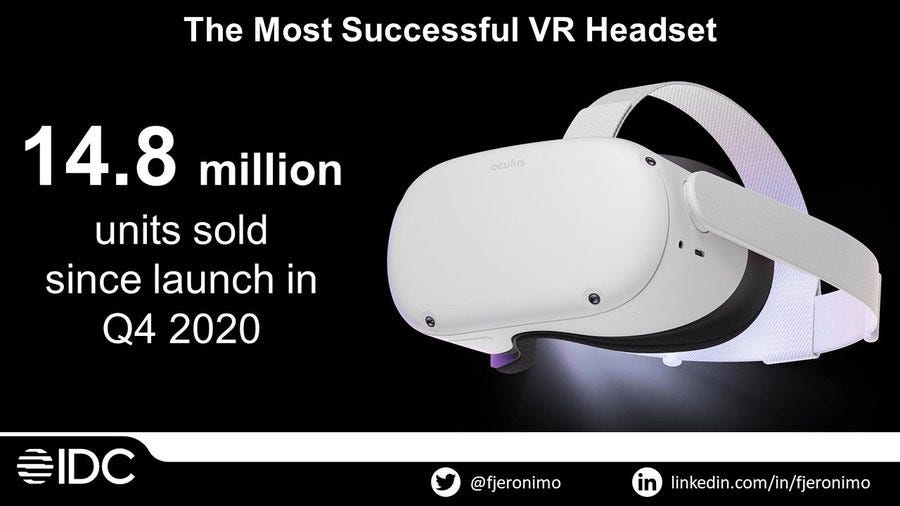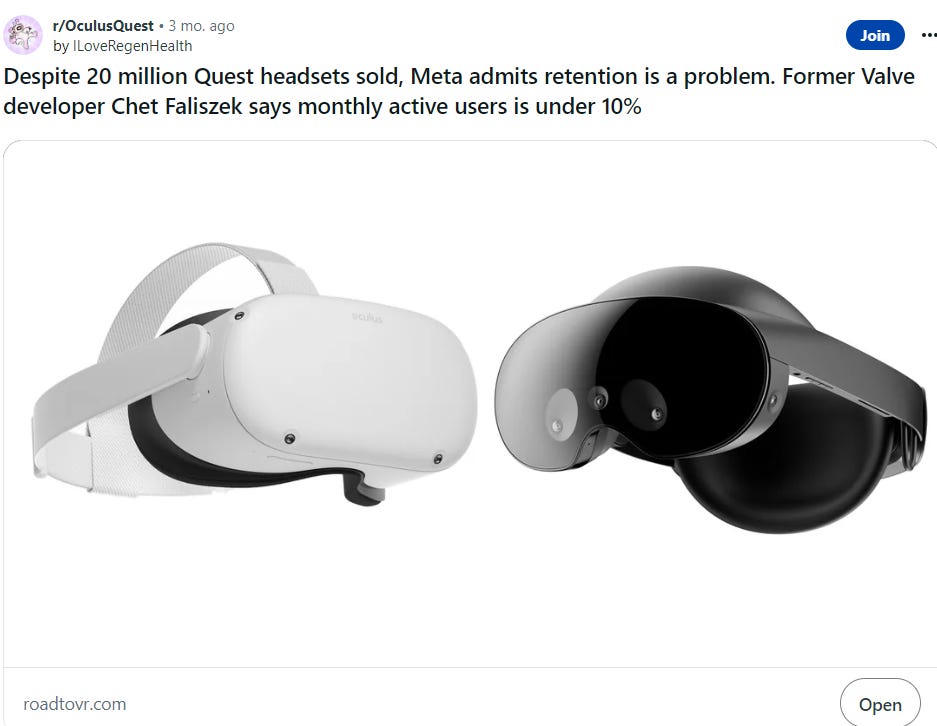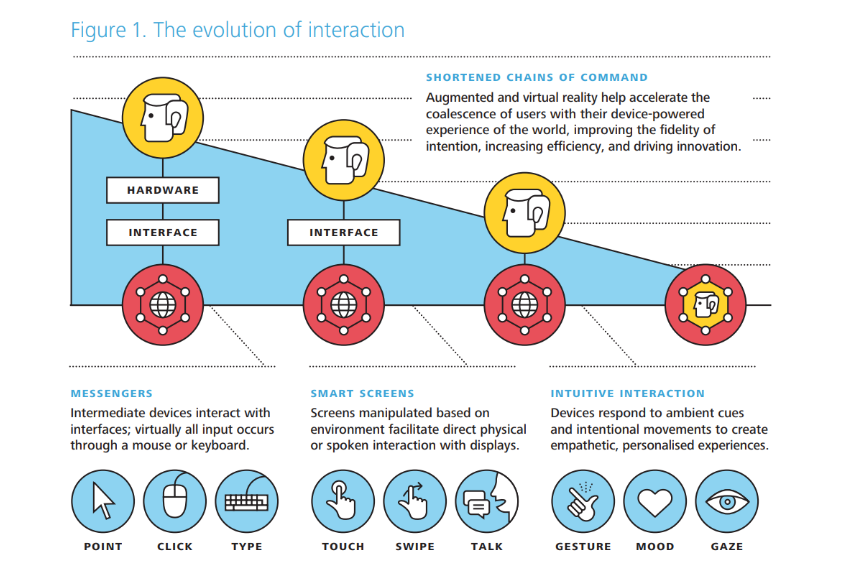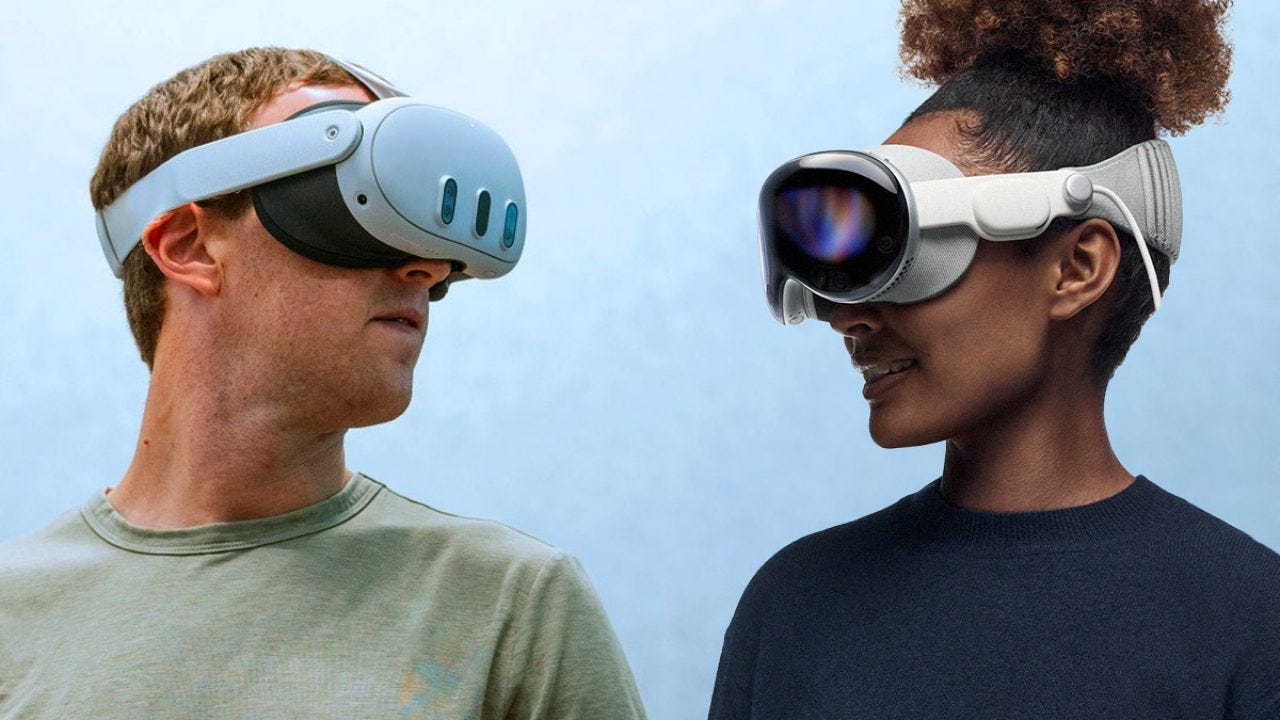Reality of Virtual Reality 🥽
I am Siddhant Davda! Welcome to the Building Dots newsletter💪
I will be sharing about startups building the future and also some insights about the Venture Capital industry.
AR and VR are often used together; most people think they are the same. But they are two different terms often used together.
What is AR?
Augmented Reality (AR) is a technology that overlays digital information, such as images, videos, or 3D objects, onto the real world, enhancing or augmenting our perception and interaction with the environment. AR merges the physical and digital worlds, allowing users to see and interact with virtual content as part of their surroundings.
Augmented reality (AR) is a technology that adds digital stuff to the real world. It's like having a magic window through which you can not only see the world around you but also see and interact with virtual things that are not there.
What is VR?
Virtual Reality (VR) is a computer-generated representation of a different world or reality. It is most commonly utilized in 3D movies and video games. It helps create realistic simulations.
VR is experiencing things that do not exist. The user is isolated from reality and immersed in a wholly imaginary universe.
Difference between AR and VR
Augmented reality uses the existing real-world environment and puts virtual information—or even a virtual world—on top of it to enhance the experience.
For example, Pokemon Go. It was one of the most popular games a few years ago. It added an additional layer on top of the real world. i.e. you could search for Pokemons in your neighborhood, on the streets, or even inside your house.
Snapchat lens is another example of AR.
Any technology that adds experience to the physical world is known as AR. In AR interaction takes place in real time and it is a combination of the physical world with that of virtual reality.
The major difference between AR and VR is that you don’t necessarily need any gadget to access AR, a smartphone is enough. But for virtual reality, you need a headset or any other device.
In AR Users always have a sense of presence in the real world whereas in VR, visual senses are under the control of the system
What is mixed reality (MR)?
Mixed reality (MR) is a technology that allows digital elements to be superimposed on the real-world environment as well as interact with one another. The MR experience allows the user to observe and interact with both digital and physical things. As a result, MR experiences are influenced by their surroundings and adapts accordingly.
MR experiences allow users to interact with both digital and physical aspects. It varies from AR, in which digital and physical elements do not interact, and VR, in which the physical or real world is entirely shut out.
Scope of VR
In 2021, Oculus sold more VR headsets than Microsoft did Xbox.
According to recent data released by the International Data Corporation, Meta's Quest 2 headset has surpassed the 14.8 million units sold mark, indicating that VR is still breaking records.
According to the same report, VR sales increased by 97% in 2021, with Q1 2022 seeing an even greater increase of 242%.
Reality of Virtual Reality
Let’s dive into the actual reality – not the virtual one.
People have always fantasized about living in a virtual world. Facebook was so certain about our virtual feature that it changed its name to Meta for Metaverse and invested $96 billion into VR technology.
Even with all their money and effort metaverse has become a joke.
So, if virtual reality is truly the future of gaming, work, education, communication, and more what’s stopping it, and will we ever experience a true virtual world?
Although humans have been developing VR technology for years it’s not hard to see why it failed in the past
It wasn't until Nintendo’s Virtual Boy in the 1990 that VR had any kind of foothold.
But the hardware was too big, experience and games were limited also everything was colored red and black. Virtual Boy was discontinued only a year after its release.
It took 17 years before VR could make any kind of comeback.
Palmer Luckey can be called the Godfather of VR. He launched the Oculus in 2012 along with his team which was truly the first virtual reality headset. Later Facebook acquired Oculus for $2 billion in 2014.
Meta's Reality Labs unit, which houses metaverse technologies, reported a $4.48 billion operational loss in Q2. Since late 2020, the Reality Labs unit has lost approximately $50 billion.
Meta’s ambitious plans to develop the metaverse are still costing the company billions of dollars every quarter.
In late 2021, Zuckerberg changed the company's name and announced that its future would be in the metaverse, a digital realm where people will work, shop, play, and learn.
But for now, it’s just a cost center, and Meta is still an online ad company.
Sales of VR headsets in the U.S. declined 2% in 2022.
Data from analyst firm CCS Insight reveals that worldwide shipments of VR headsets dropped more than 12% year over year to 9.6 million in 2022.
One major thing the VR world lacks is a breakout hit or a killer app.
In the console market, blockbuster games like FIFA and Call of Duty are shipping hundreds of millions of products.
Although multiple articles make it sound like VR is doing well by stating things like VR has a total of 171 million active users they are talking about annual users. So if someone picks up a headset for the first time he will be counted as a VR user.
Of the 171 million VR users 110 million are augmented reality users. So, there are only 60 million VR users.
What’s crazier is even from the 60 million users only 10% are MAU. Only 6-7 million users play monthly.
To give you a context on how bad that is, Pokemon Go as of May 2023 had nearly 80 million monthly players. League of Legends has 150 million monthly players. Multiple games have 10 times the monthly user base of VR as a whole and I doubt 100 billions of dollars are poured into those games.
This indicates only one thing VR is a Fake Trend. Sam Altman founder of OpenAI put it this way, “Fake trend, or at least a fake trend as of August 2018 I would say is VR. Today most people I know that own a VR headset use it never or very rarely. So even if a lot of people talk about it or maybe even buy it there is no intense usage per user among the early adopters that I think you would want to see”
VR technology is stuck with the early adopters and there are a few reasons for it:
1- VR headset is too expensive and bulky
2- Most VR games are gimmicky
3- They would feel good for an hour or two after which you start feeling nauseous
4- VR is primarily single-player
The question is not will VR be successful the question we need to ask is what needs to happen for VR to be successful and the answer lies in Pokemon Go. It was released back in 2016 and it had taken the world by storm. People from all age groups were addicted to this game.
But why did it become so successful? Some might say that Pokemon itself is a widely watched cartoon and it is very popular but even the best-selling Pokemon game of all time has only sold 31 million copies and Pokemon Go had 232 million players at its peak. So, it was not popular just because of Pokemon or any other Pokemon game.
What led to its success was that it made people go out, connect with people, reconnect with old friends catch Pokemons, and have fun.
Not just AR, but games like Among Us which blew up in lockdown did quite well. There is no barrier to entry as the game is playable on a mobile phone that everyone already owns and also can be played by a bunch of friends together making it fun.
These things can be achieved with augmented reality and hence it needs to succeed before VR.
AR is taking our world and adding a digital lens on top of it while VR wants you to enter a complete virtual world. If I wanted to experience Pokemon Go in VR I would need a headset, headphones, and hand gear but in AR all I need is my smartphone which makes it easily scalable.
That in-person experience in AR is so much better than virtual one and it is called the natural progression of technology. As tech evolves it should simply improve the experience.
This is why metaverse and VR are failing. Meta is jumping the gun and violating the six-degree rule. This rule is the idea that you cannot shift a market more than six degrees with your product and if you try to it’s unlikely that your company or product will be successful.
Human beings are slow-moving creatures we aren’t quick to adopt new things or trends.
For example, people look at smartphones as this world-changing technology but look at the trend first we got people comfortable with using phones, then we got people to buy these phones and put them in their homes after this people were sold on to the idea of a mobile phone. Slowly people moved from mobile phones to phones with messaging and mailing features, and then came smartphones. So this was a gradual shift in the technology. But still, it took 15 years for global adoption because it takes time.
This is why Google Glass failed so hard. Google was banking on AR as being the next thing after smartphones. Google launched its glasses in 2013 but people had only started using smartphones for a few years and yet only a few had made a shift from a flip phone to a smartphone.
No company understands trends better than Apple. They seem to know better than everyone when the market is ready for the next big thing. Just look at their track record, iPod, iPhone, AirPod, apple watch, and now Apple Vision Pro.
Apple has 5000 patents filed for the Apple Vison Pro. One of them is a direct retinal projection to beam AR images onto your eyeballs so that one doesn’t experience nausea.
But even they learned a $1.4bn lesson in how companies can be too product-oriented and not market-oriented enough.
That is how much revenue the company will roughly lose after it recently cut sales projections for the $3,500 Vision Pro headset in half from around 800,000 to 400,000.
Conclusion
I had a chance to try the Oculus Quest 2 and here’s how my experience was
Though the experience was great I couldn’t wear the headset for more than 10 mins. I started feeling nauseous after a while.
There was too much strain on my eyes
While the initial wow factor is present the first time you try it, it tends to fade after the second or third time.
If I had a chance to attend Arijit Singh’s concert in the metaverse or real world I would any day choose the physical event. Because the vibe in an offline event is something else that cannot be replaced by metaverse.
How many people would be able to afford a 30k-40k headset?
There are still many questions that need to be answered before we can fully embrace the potential of Virtual Reality.
If you have any thoughts or questions share them in the comments :)
If you found this insightful, do drop a like and subscribe as it would mean a lot to me ❤️


